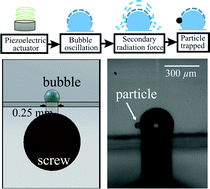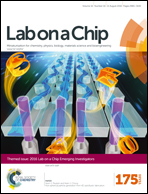Onset of particle trapping and release via acoustic bubbles
Abstract
Trapping and sorting of micro-sized objects is one important application of lab on a chip devices, with the use of acoustic bubbles emerging as an effective, non-contact method. Acoustically actuated bubbles are known to exert a secondary radiation force (FSR) on micro-particles and stabilize them on the bubble surface, when this radiation force exceeds the external hydrodynamic forces that act to keep the particles in motion. While the theoretical expression of FSR has been derived by Nyborg decades ago, no direct experimental validation of this force has been performed, and the relationship between FSR and the bubble's ability to trap particles in a given lab on a chip device remains largely empirical. In order to quantify the connection between the bubble oscillation and the resultant FSR, we experimentally measure the amplitude of bubble oscillations that give rise to FSR and observe the trapping and release of a single microsphere in the presence of the mean flow at the corresponding acoustic parameters using an acoustofluidic device. By combining well-developed theories that connect bubble oscillations to the acoustic actuation, we derive the expression for the critical input voltage that leads to particle release into the flow, in good agreement with the experiments.

- This article is part of the themed collection: 2016 Lab on a Chip Emerging Investigators


 Please wait while we load your content...
Please wait while we load your content...